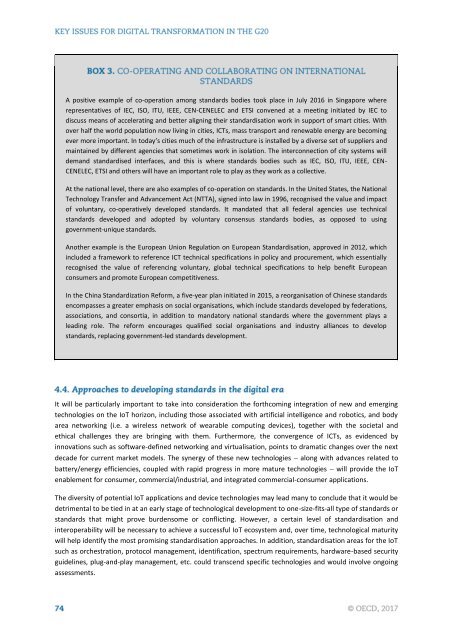KEY ISSUES FOR DIGITAL TRANSFORMATION IN THE G20
2jz0oUm
2jz0oUm
Create successful ePaper yourself
Turn your PDF publications into a flip-book with our unique Google optimized e-Paper software.
A positive example of co-operation among standards bodies took place in July 2016 in Singapore where<br />
representatives of IEC, ISO, ITU, IEEE, CEN-CENELEC and ETSI convened at a meeting initiated by IEC to<br />
discuss means of accelerating and better aligning their standardisation work in support of smart cities. With<br />
over half the world population now living in cities, ICTs, mass transport and renewable energy are becoming<br />
ever more important. In today’s cities much of the infrastructure is installed by a diverse set of suppliers and<br />
maintained by different agencies that sometimes work in isolation. The interconnection of city systems will<br />
demand standardised interfaces, and this is where standards bodies such as IEC, ISO, ITU, IEEE, CEN-<br />
CENELEC, ETSI and others will have an important role to play as they work as a collective.<br />
At the national level, there are also examples of co-operation on standards. In the United States, the National<br />
Technology Transfer and Advancement Act (NTTA), signed into law in 1996, recognised the value and impact<br />
of voluntary, co-operatively developed standards. It mandated that all federal agencies use technical<br />
standards developed and adopted by voluntary consensus standards bodies, as opposed to using<br />
government-unique standards.<br />
Another example is the European Union Regulation on European Standardisation, approved in 2012, which<br />
included a framework to reference ICT technical specifications in policy and procurement, which essentially<br />
recognised the value of referencing voluntary, global technical specifications to help benefit European<br />
consumers and promote European competitiveness.<br />
In the China Standardization Reform, a five-year plan initiated in 2015, a reorganisation of Chinese standards<br />
encompasses a greater emphasis on social organisations, which include standards developed by federations,<br />
associations, and consortia, in addition to mandatory national standards where the government plays a<br />
leading role. The reform encourages qualified social organisations and industry alliances to develop<br />
standards, replacing government-led standards development.<br />
It will be particularly important to take into consideration the forthcoming integration of new and emerging<br />
technologies on the IoT horizon, including those associated with artificial intelligence and robotics, and body<br />
area networking (i.e. a wireless network of wearable computing devices), together with the societal and<br />
ethical challenges they are bringing with them. Furthermore, the convergence of ICTs, as evidenced by<br />
innovations such as software-defined networking and virtualisation, points to dramatic changes over the next<br />
decade for current market models. The synergy of these new technologies along with advances related to<br />
battery/energy efficiencies, coupled with rapid progress in more mature technologies will provide the IoT<br />
enablement for consumer, commercial/industrial, and integrated commercial-consumer applications.<br />
The diversity of potential IoT applications and device technologies may lead many to conclude that it would be<br />
detrimental to be tied in at an early stage of technological development to one-size-fits-all type of standards or<br />
standards that might prove burdensome or conflicting. However, a certain level of standardisation and<br />
interoperability will be necessary to achieve a successful IoT ecosystem and, over time, technological maturity<br />
will help identify the most promising standardisation approaches. In addition, standardisation areas for the IoT<br />
such as orchestration, protocol management, identification, spectrum requirements, hardware-based security<br />
guidelines, plug-and-play management, etc. could transcend specific technologies and would involve ongoing<br />
assessments.


